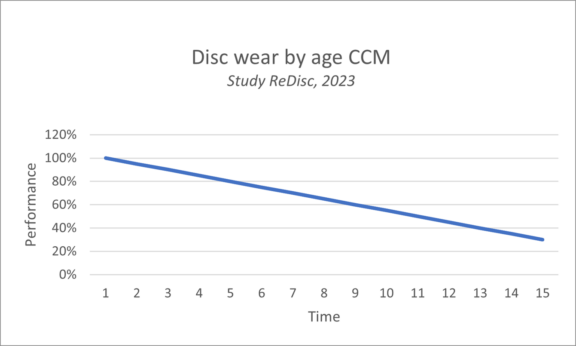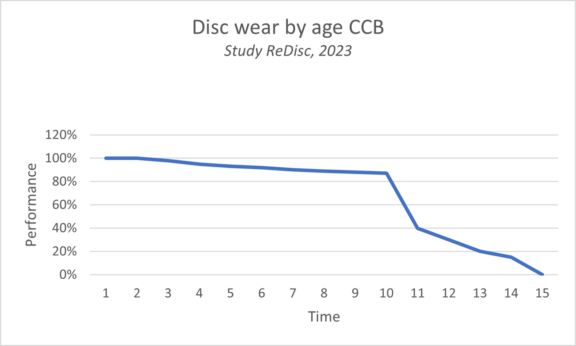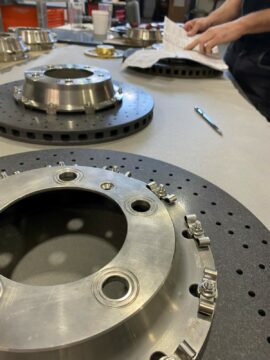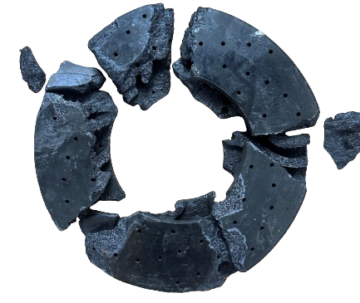Carbon Ceramic Brake discs are subject to two different phenomena: Wear and oxidation. We will explain their differences in order to understand what solutions can be applied.
You can read about Carbon Ceramic Brake discs also here Carbon-ceramic discs | Brembo – Official Website.
Brake oxidation
Carbon from the brakes naturally combines with oxygen from the ambient air to become carbon dioxide (CO2). Under normal circumstances, the oxidation occurs at a very slow rate. However, the rate of oxidation can be accelerated by external factors such as high temperature. This results in a loss of carbon mass from the brake disks, carbon softening, and delamination. It can ultimately lead to brake rupture if an affected brake is not changed in due time.
At the Redisc refurbishment process, we have developed an Oxy coating, which we apply at the end of the process to all “non-friction” surfaces of the disc. By that, we protect the disc from oxygen reacting with the disc carbon thus prolonging the disc’s lifetime.
Brake wear
Brake wear is the progressive loss of width on the brake disks due to friction. Ceramic brake pads can create excessive rotor wear if rotors are not the same high quality as the brake pads themselves.
CCM technology
The performance of the CCM discs is slowly decreasing. Below you can find an example of a regular drive, how the performance decreases linearly depending on the age of the vehicle and normal use (no racetracks are included in this study).

Such performance decrease is very important as the driver is able to feel performance loss and can on-time predict/ replace disc.
CCB technology
The performance of the discs is not linearly decreasing (like CCM), but it is more or less constant. However, it can fail at one point, so it is hard to predict when the disk needs to be replaced.

For re-surfacing (refurbishing), it is optimal that discs are at least 50 % of their performance according to weight/ thickness parameters.
CCM or CCB Carbon Ceramic Brake Discs?
As indicated each technology (CCM/ CCB) has its advantages as well as disadvantages for users. CCM loose performance faster, but discs lifetime is easier to predict due to linear performance decrease. On the other hand, CCB last longer, but time of disc default is hard to predict.
When to change Carbon Ceramic Brake Disc?
It is very hard (almost impossible) for service technicians to follow the performance loss through time, to be able to indicate the need for disc replacement.
Therefore, simple experimental weighting and disc thickness measuring has been introduced by producers of the disc. The method is not at all exact but offer service technicians a tool to decide when to replace the disc.
As weight/ thickness is not reliable/ not the only parameter for disc condition, Brembo has in cooperation with Proceq developed new device (Carboteq), to indicate quality/ wear of the disc of CCB’s. For that all new discs have indication what was Carboteq value when new and what is recommended value for disc replacement.
REFURBISHMENT, MINIMUM WEIGHT AND THICKNESS OF CARBON CERAMIC BRAKE DISCS
In Redisc, we use pyrolysis to fill air gaps (with ceramic) inside the core of the disc and by that strengthen it.
More information are also here https://www.redisc.si/en/services/
Our process is:
- When we get the disc, we sand off all the remains of the pads that are welded on the disc. In this way, the weight of the disc is reduced by approx. 50-100 g. It is important to understand that this is “unnecessary” or “non-functional” disc weight.
- Then, during the core strengthening process, 30-120 g of additional weight (ceramic) is added into the disc core.
- Finally, we have the grinding process, where the top surface (again “non-functional/unusable”) is sanded off. In this way, we can remove up to 150 g but it all depends on the quality of the disc; we have to grind as much as needed to get a healthy material, smooth and even surface. Smooth surface (without cavities) result in larger friction surface, better heat dissipation (better cooling), less brake pad deposits…better performance.
Redisc process/ challenges
When we receive the discs, we remove up to 200 g of “bad” material (remnants of pads, top damaged layer), and add 30-120 g of mass to the inside of the disc (this actually changes the quality of the disc, as the base is stronger / denser).
In other words, we usually leave the disc lighter than we got it and even thinner, by being much more compact with higher core density and better heat dissipation.
However, that is not visible to service technicians, which have only weight/ thickness method to judge disc quality.
For example: disc weight is result of weight of disc, disc hub, screws, bolts, springs, brake pad deposits, dirt… If at slightly used disc only hub and bolts are replaced for lighter version (different design, titanium material…), disc weight is decreased to lower than factory specified. As such, performance has increased, but discs are not acceptable by official dealers according to weight measurement.
Therefore, we at Redisc always use (besides weight/ thickness parameters) Carboteq to follow the improved structure, which at the end is the most influential parameter of performance and lifetime of the disc.
Warning Official services (Ferrari Service, Porsche Warranty) may not accept the refurbished ones due to the fact discs are thinner and lighter – even though there are safe and fully functional. If disc’s initial condition is on or even below the minimum values, discs will be below the minimum after refurbishment. Please inform us an about this in advance to give you a proper evaluation.

